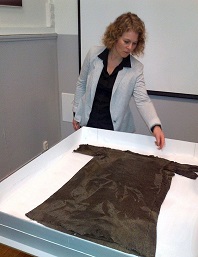 Pre-Viking tunic found on glacier as warming trend aids archaeology
Pre-Viking tunic found on glacier as warming trend aids archaeology
A pre-Viking woolen tunic found beside a thawing glacier in south Norway shows how global warming is proving something of a boon for archaeology, scientists said on Thursday. - The greenish-brown, loose-fitting outer clothing — suitable for a person up to about 5 feet, 9 inches tall (176 centimeters) — was found 6,560 feet (2,000 meters) above sea level on what may have been a Roman-era trade route in south Norway. Carbon dating showed it was made around the year 300. A Viking mitten dating from the year 800 and an ornate walking stick, a Bronze Age leather shoe, ancient bows, and arrowheads used to hunt reindeer are also among 1,600 artifacts found in Norway's southern mountains since thawing accelerated in 2006. The archaeologists said the tunic showed that Norway's Lendbreen glacier, where it was found, had not been so small since 300. When exposed to air, untreated ancient fabrics can disintegrate in weeks because of insect and bacteria attacks. "The tunic was well-used — it was repaired several times," said Marianne Vedeler, a conservation expert at Norway's Museum of Cultural History. The tunic is made of lamb's wool with a diamond pattern that had darkened with time. Only a handful of similar tunics have survived so long in Europe. The experts in Oslo said one puzzle was why anyone would take off a warm tunic by a glacier. One possibility was that the owner was suffering from cold in a snowstorm and grew confused with hypothermia, which sometimes makes suffers take off clothing because they wrongly feel hot.





